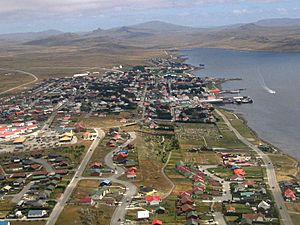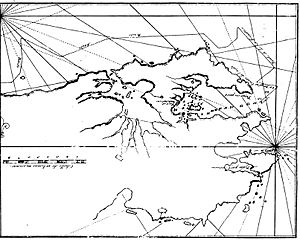Moody Brook facts for kids

Moody Brook is a small stream on East Falkland in the Falkland Islands. It flows into Stanley Harbour, which is near the town of Stanley.
This area was once home to army barracks. These barracks were attacked in 1982 during the Argentine invasion of the Falkland Islands. The brook is named after Richard Clement Moody, who was a governor of the islands.
Contents
The Attack on Moody Brook Barracks
In 1982, during the invasion, Argentine forces planned to capture key locations. One main group headed towards Moody Brook Barracks. They had to travel about six miles over rough land in the dark.
The Difficult Journey
An Argentine officer, Lieutenant-Commander Sanchez-Sabarots, described their journey. He said it was a clear night, but clouds often hid the moon. Carrying heavy gear made the walk very hard. The group split into three parts because of the difficult conditions.
They had only one night vision device, which the lead soldier used. One small group got separated when a vehicle passed by. Another group lost contact, and one soldier even fell, breaking his ankle. He had to be left behind with another soldier to help him.
They finally reached Moody Brook by 5:30 AM. This was just on time, but it left no extra time to scout the area as they had hoped.
The Barracks Assault
The Argentine Marines thought British Royal Marines were sleeping inside the barracks. The buildings were quiet, except for a light on in the commander's office. They saw no guards. The only sounds were occasional animal calls.
The Argentine commander decided to start the attack. Their plan was to use tear gas to force the British soldiers out. Their orders were to avoid causing injuries if possible. This was a very difficult mission for them. As commandos, they were trained to fight aggressively.
They surrounded the barracks with machine-gun teams. They left only one way for anyone to escape, which led away from Stanley. This way, any escaping soldiers could not reach the town to help the British forces there.
Then, they threw gas grenades into each building. But nothing happened. The barracks were empty.
After the Attack
The noise of the grenades warned Major Norman, a British officer, that Argentines were on the island. He quickly drove back to Government House. Realizing the attack was at Moody Brook, he ordered all British troops to gather at Government House. This helped centralize their defense.
Later, some Royal Marines were allowed to return to the barracks to get their personal items. Major Norman said the barracks walls were full of machine gun holes. They also had marks from white phosphorus grenades. He described it as a "classic housekeeping operation," meaning it was a thorough attack.
Images for kids
See also
 In Spanish: Arroyo Caprichoso para niños
In Spanish: Arroyo Caprichoso para niños



